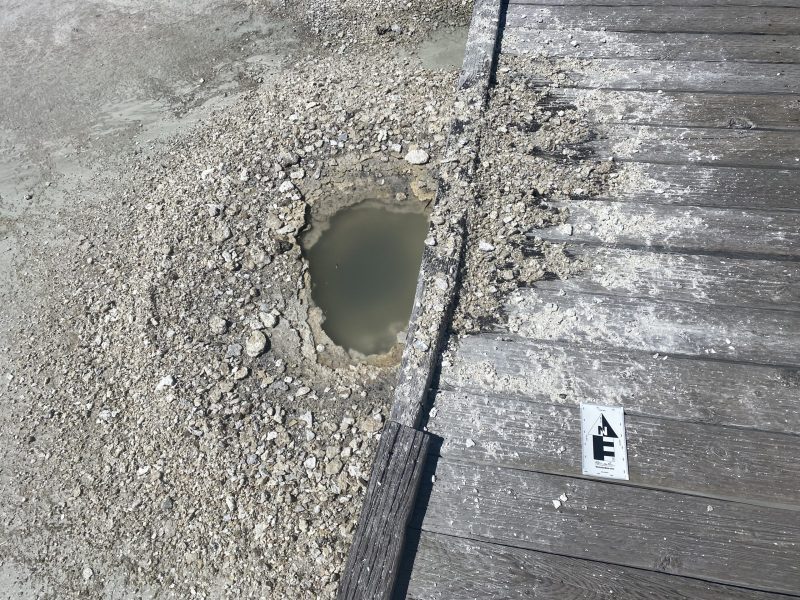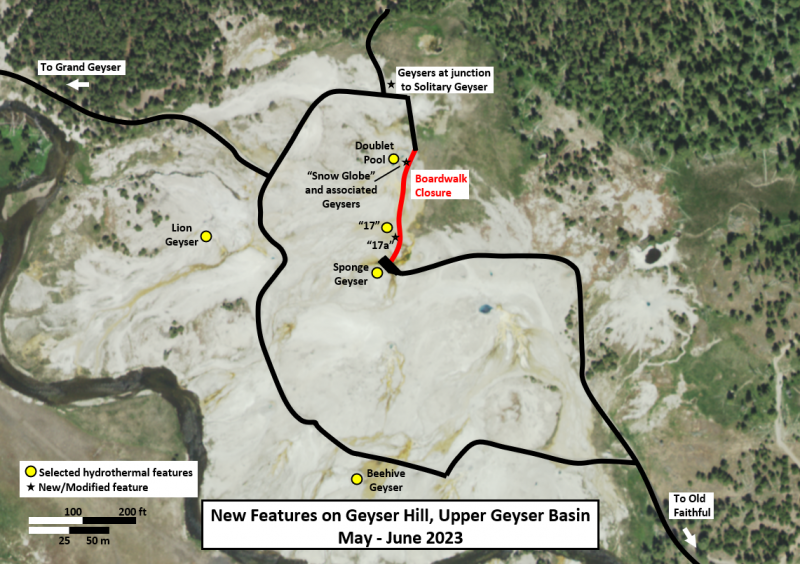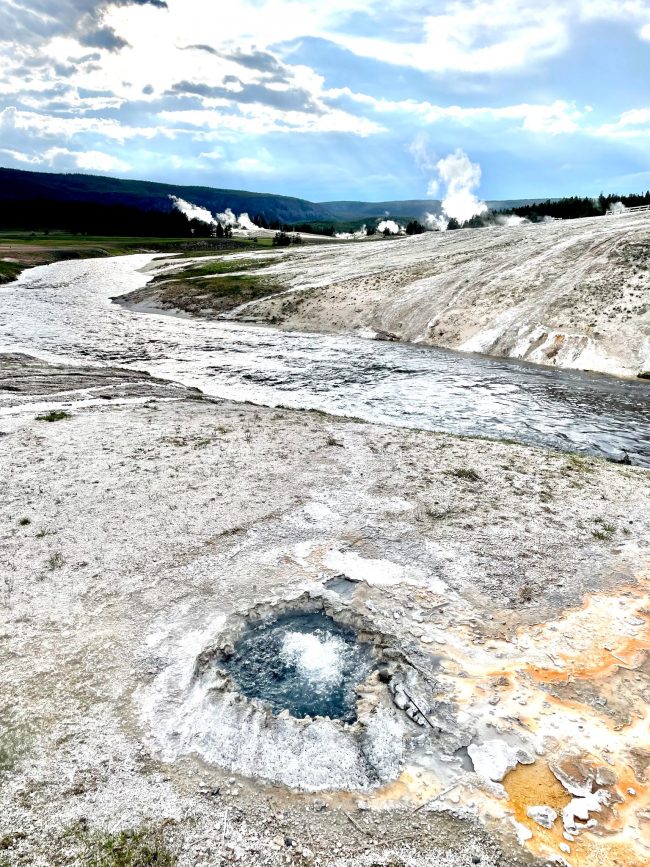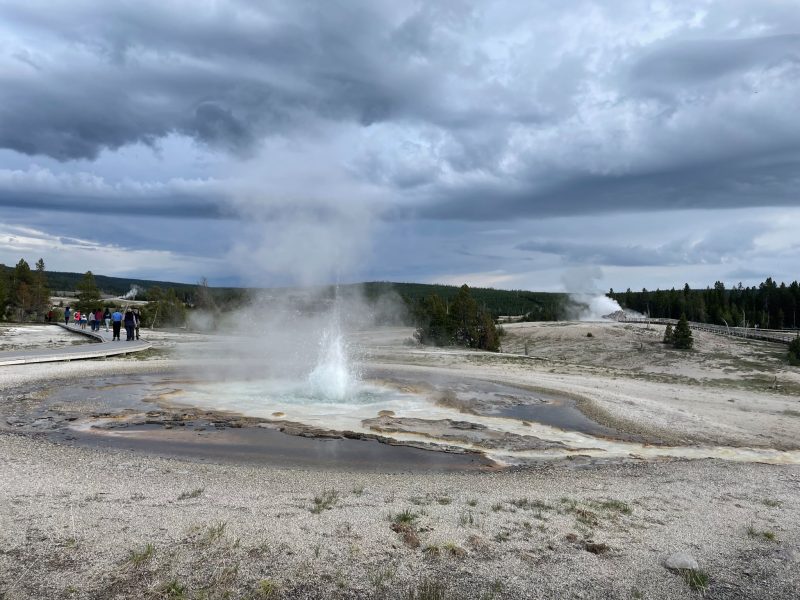
Recent thermal activity at Yellowstone geyser
Since late May 2023, there’s been a general increase in thermal and geyser activity at Geyser Hill, near the famous Old Faithful geyser in Yellowstone National Park.
The recent activity started on May 24, 2023. That’s when observers on Geyser Hill in Yellowstone’s Upper Geyser Basin, near Old Faithful, witnessed something that hadn’t been seen for two years: an eruption of Aurum Geyser. This medium-sized but charismatic geyser lies at a bend of the boardwalk that circles Geyser Hill, in front of a shallow pool filled with geyser eggs (smooth pebbles made of layers of mineral precipitated from geyser water).
According to citizen scientist observations, Aurum was witnessed erupting nearly 30 times over the subsequent 14 days, throwing water about 6 meters (20 feet) in the air.
Aurum’s awakening was not the only change on Geyser Hill in last the few weeks. The same day Aurum erupted, the popular Beehive Geyser erupted twice. Beehive typically erupts about every 18-22 hours, although with substantial variation. On May 24, a series of eruptions began with a shorter interval of about 15–16 hours. Small features became more active, too.
By May 30, a small geyser known as UNNG-GHG-17, in the runoff channel of Doublet Pool, began erupting for the first time since 2018. It was throwing water about 1 meter (3 feet) into the air. And it settled on a frequency of about once every 90 minutes for the first few days of its reawakening.
The changes are reminiscent of those that occurred in the same area in 2018 and are a testament to the dynamic nature of Yellowstone’s geyser basins.

Citizen scientists helped monitor
The unusual activity on Geyser Hill attracted community interest. Citizen scientist Graham Meech watched “17” erupt 20 times over a period of two days, carefully noting eruption times and how the intervals between eruptions varied. Meech’s data cover a critical period in the eruptive cycle of “17” that would otherwise not have been captured before park service personnel could put monitoring equipment on the geyser.
When “17” began to erupt again, a new feature – dubbed UNNG-GHG-17a – broke through the surface. “17a” is located about 3 meters (10 feet) southeast of “17” and next to a boardwalk.
As the new feature erupted, it churned up broken bits of sinter (rock made of minerals precipitated from geyser water) and tossed out debris, some of which landed on the boardwalk.
By June 5, the hole from “17a” had grown to a diameter of 0.75 m (2.4 feet).
Meech noted on May 30 that the activity of “17” and “17a” was closely linked, with “17a” consistently erupting about 8 minutes after “17”.
Just a few days later, the new geyser’s behavior was markedly different. Whereas before the geyser would drain between eruptions, park geology staff visiting the site on June 5 found a mostly stagnant pool filled to the brim with water.
“17” and “17a” started having some eruptions independent of each other, and the intervals between eruptions lengthened. Preliminary analysis of temperature logger data indicates that “17a” had 13 eruptions on June 2, with an average interval of 1.8 hours between eruption. By June 5 this had dropped to 7 eruptions, with an average interval of 3.7 hours.
The activity occurring on Geyser Hill bears a remarkable similarity to activity that occurred in the same area in September 2018. That time period included a rare eruption of Ear Spring that brought decades worth of human trash to the surface, including coins, hats, cans, a cinder block, and a baby’s pacifier. In fact, it was during this period that the feature known as “17” first formed!
Not over yet
The unusual conditions of the May 2023 event have not ended. While activity at “17” and “17a” slowed down, a previously existing feature near Doublet Pool, half under the boardwalk, sprang to life. Named by some “Snow Globe” for the way it churns up small flakes of sinter, this feature began erupting, throwing 88 °C (191 °F) water at least a foot or two in the air, with some droplets landing on the boardwalk.
Activity at this feature was near-constant on June 4, with eruptions reported about every 90 seconds. Then, on June 7, a new vent a few inches west of “Snow Globe” opened up, splashing out water in frequent eruptions, and draining with a whirlpool.
As a result of this unusual activity, a boardwalk closure was put into effect between Sponge Geyser and Doublet Pool to protect visitors and staff from tossed rocks and boiling water.
Yellowstone National Park geology staff have responded to the May 2023 Geyser Hill event by placing temperature dataloggers and other monitoring equipment near “17,” “17a,” and the feature by Doublet Pool.
They hope that these data will not only document the unusual activity, but also aid park staff in determining when it is safe to lift boardwalk closures.

Yellowstone is dynamic
Changes like those now occurring on Geyser Hill occur frequently in Yellowstone’s geyser basins. Besides the September 2018 event on Geyser Hill, a major thermal event occurred in 2003 at Norris Geyser Basin, with the formation of several new features, eruptions of previously non-erupting pools, and a general increase in surface temperatures.
This activity ultimately forced the rerouting of several boardwalks in the area. There was also the observation of a new thermal area that formed in the past 20 years near Tern Lake, on the east side of the park.
In most geologic contexts, change is almost imperceptibly slow. This is not the case in hydrothermal areas, which are incredibly dynamic. By the same token, it is hard to predict the course this particular thermal event will take. Geyser Hill could rapidly cool off and return to its “normal” activity, or additional features could form or continue to grow.
The most constant thing about Yellowstone’s geyser basins is their changeability.
ACKNOWLEDGEMENT: Tracking hydrothermal activity is a time-consuming effort that has benefitted greatly from community involvement. The observations discussed in this article include input from Graham Meech, Lori and Steve Walker, Shannan Marack, AJ Ferrara, and several other members of Yellowstone National Park staff and the public.

Bottom line: Since late May 2023, there’s been a general increase in thermal and geyser activity in Yellowstone National Park.
The post Yellowstone geysers: New features and new eruptions first appeared on EarthSky.
0 Commentaires